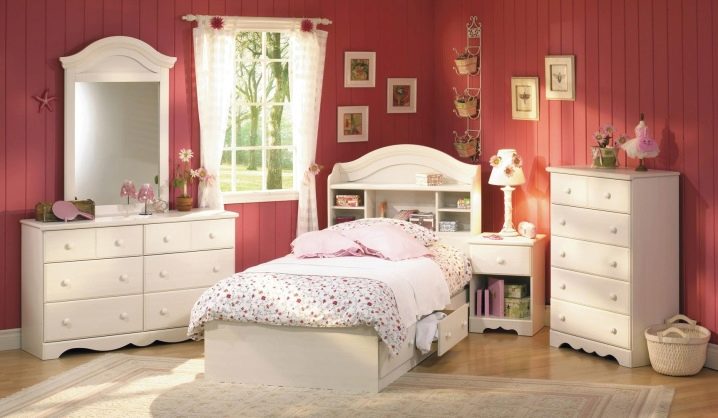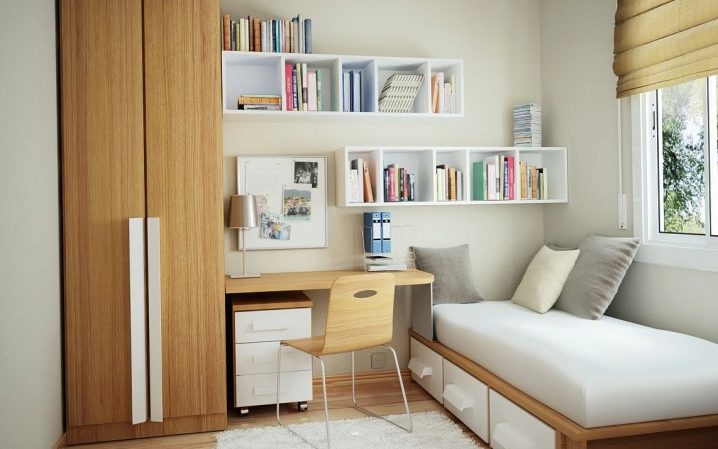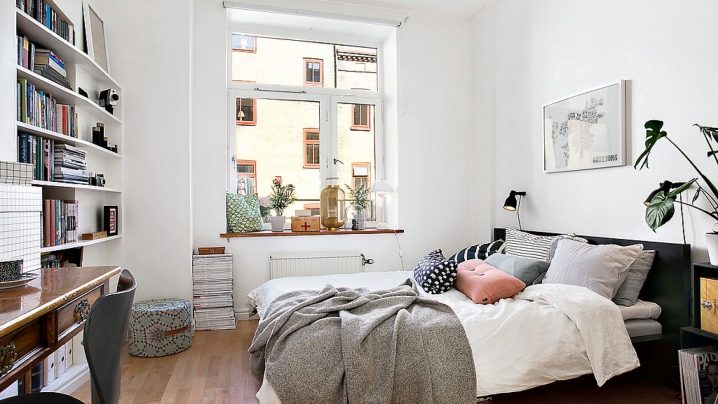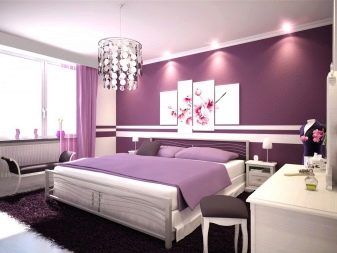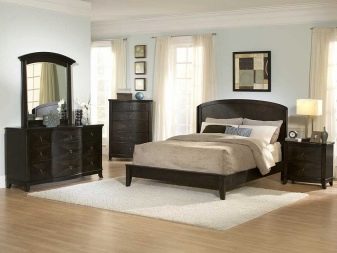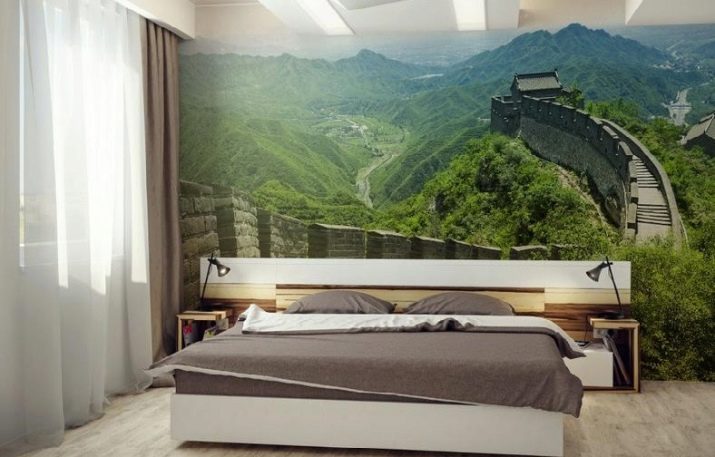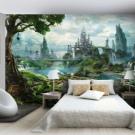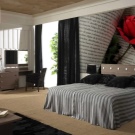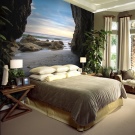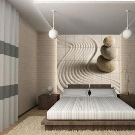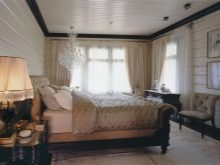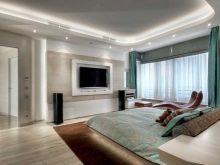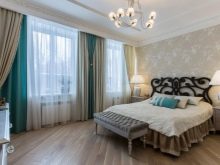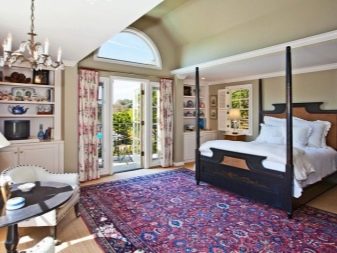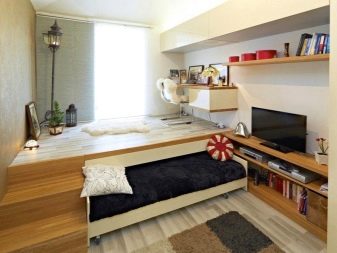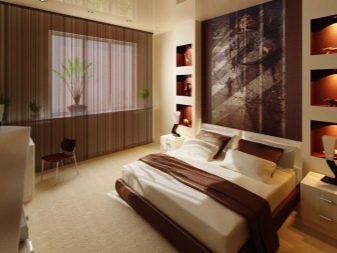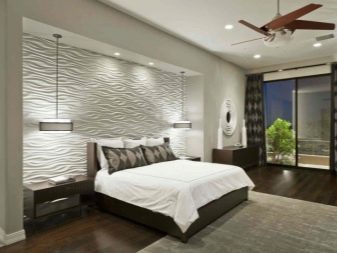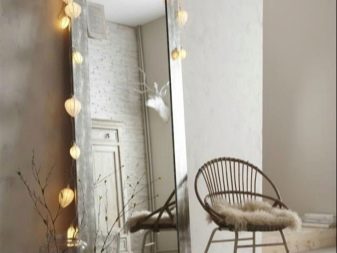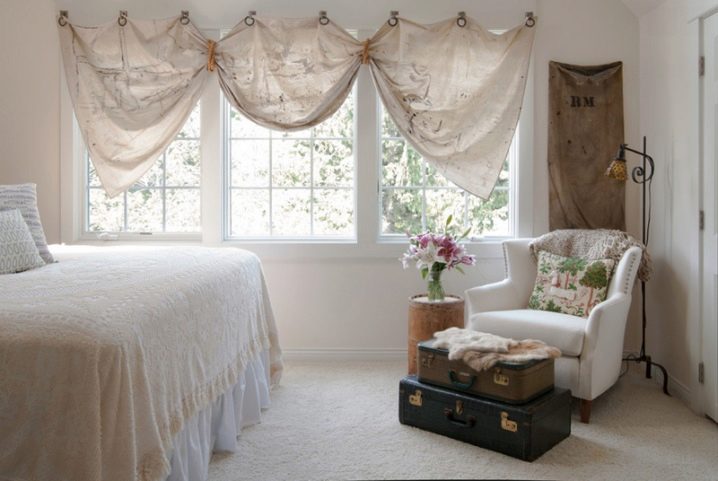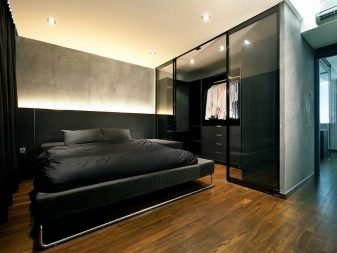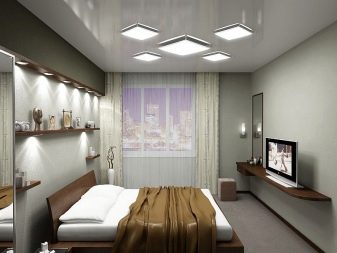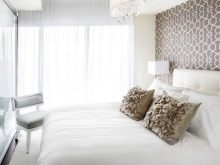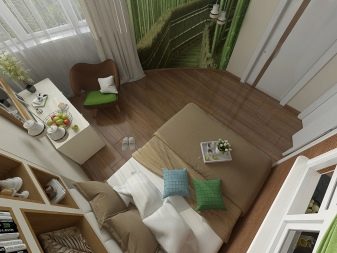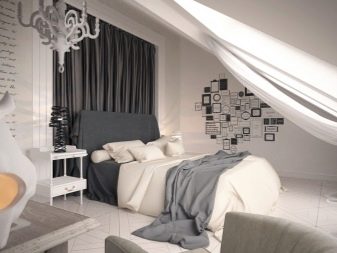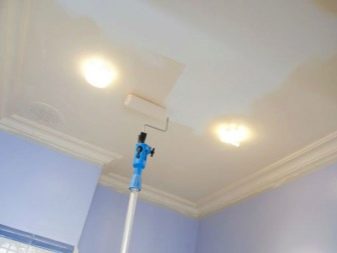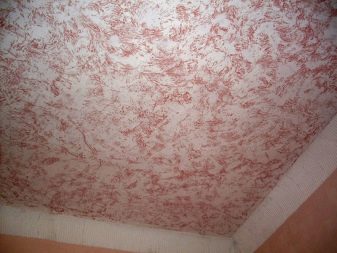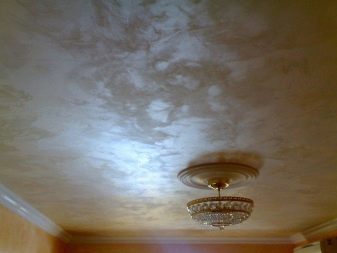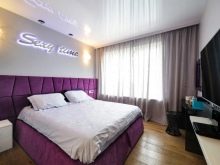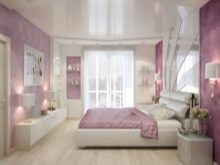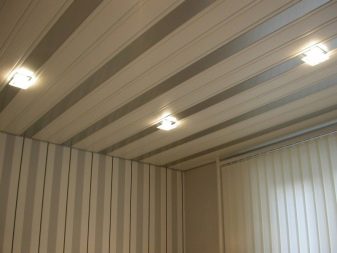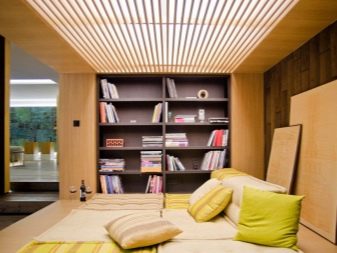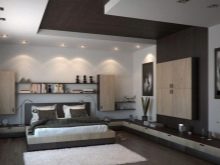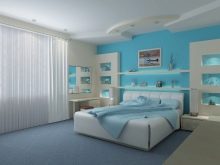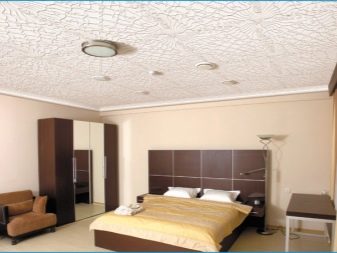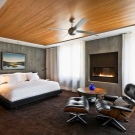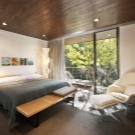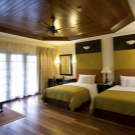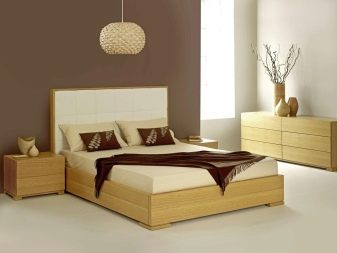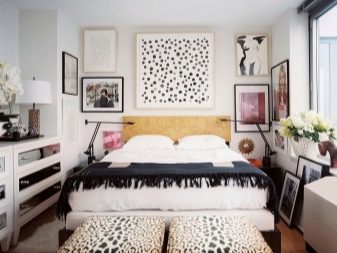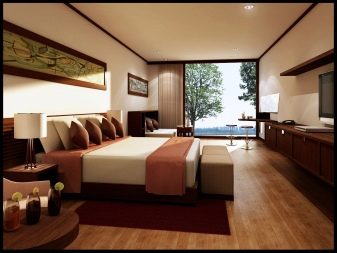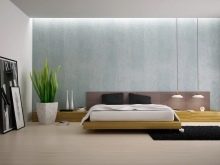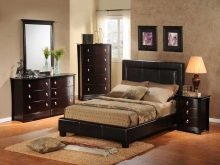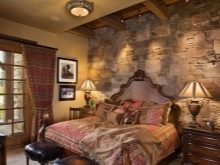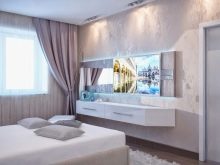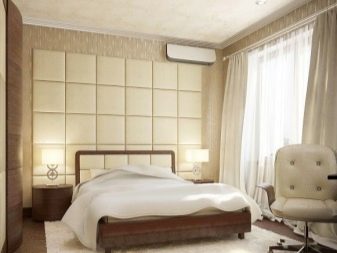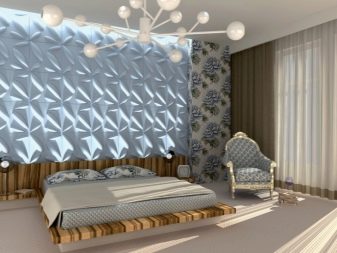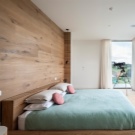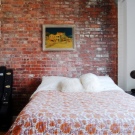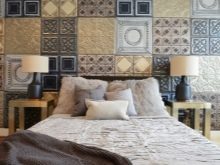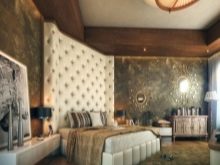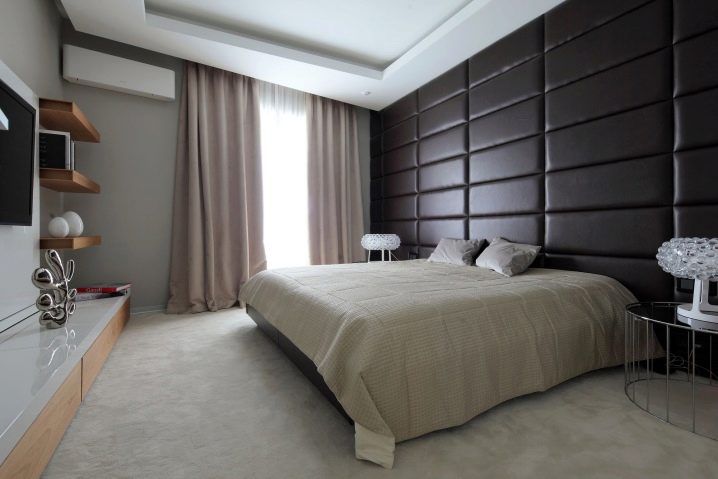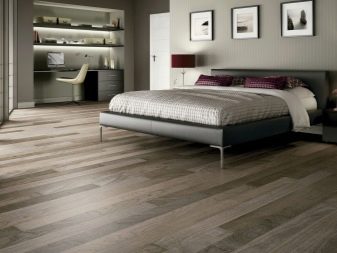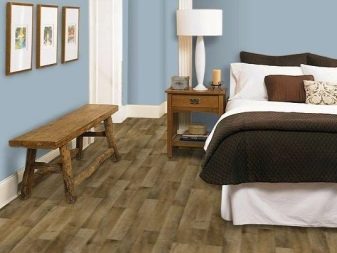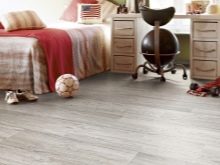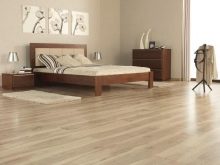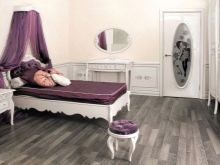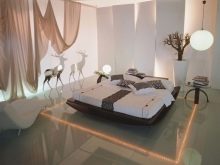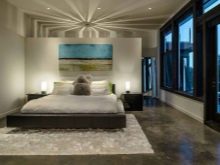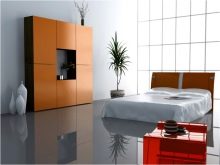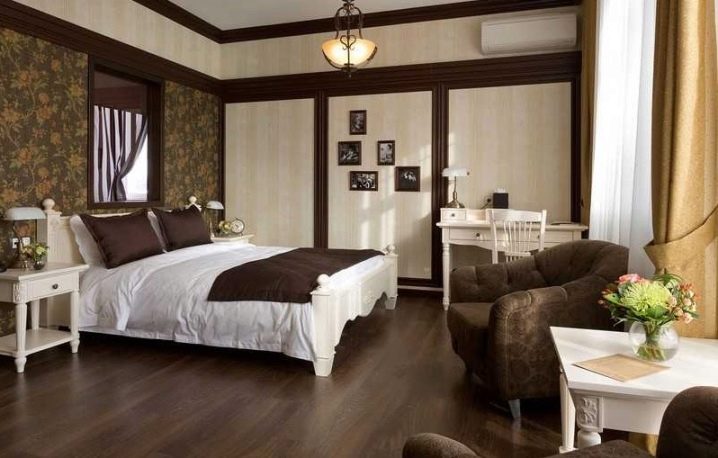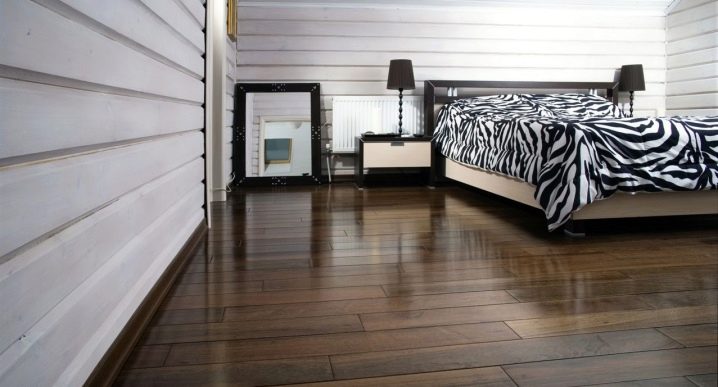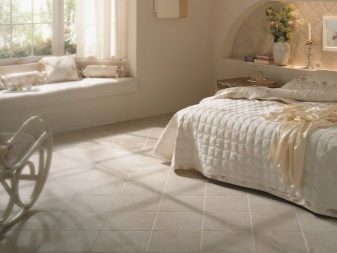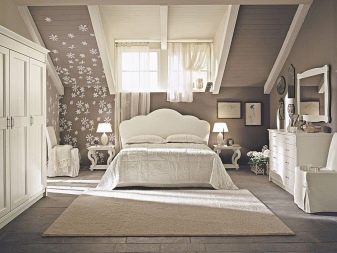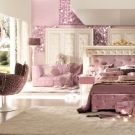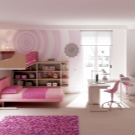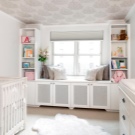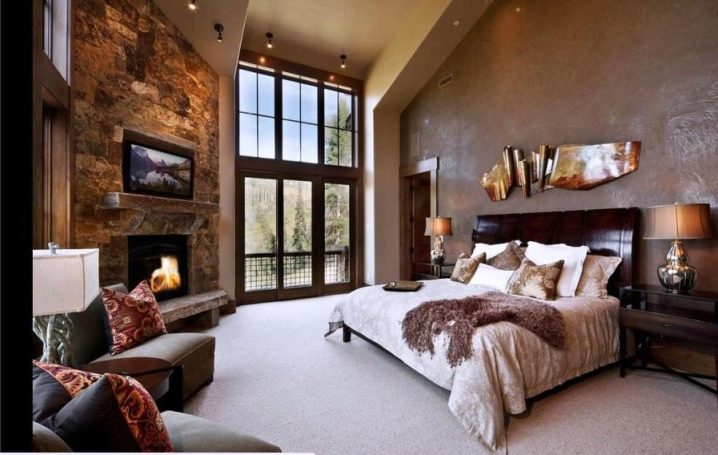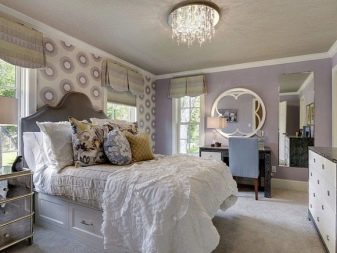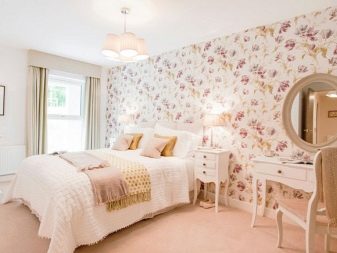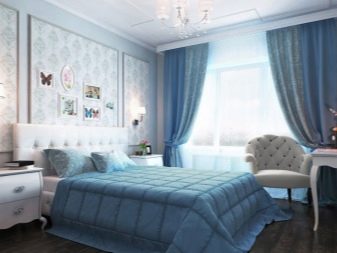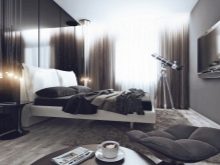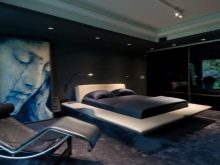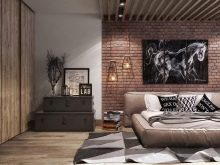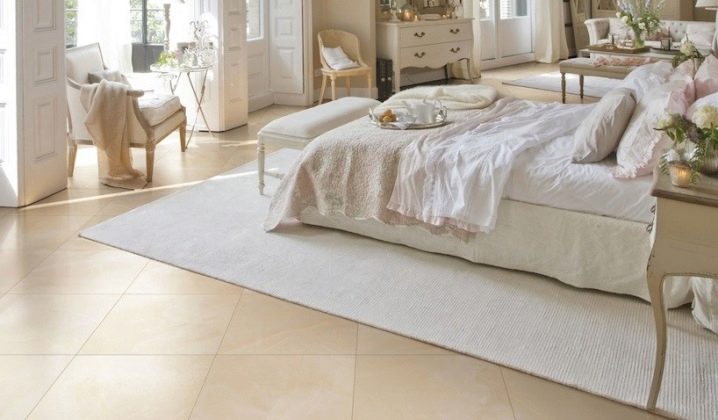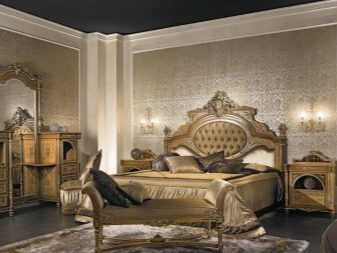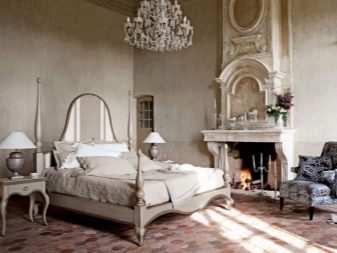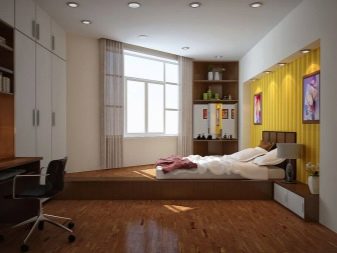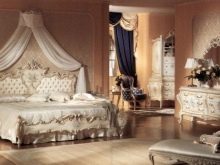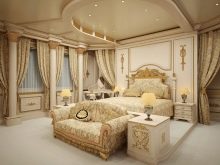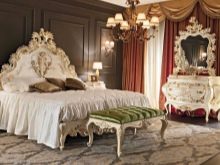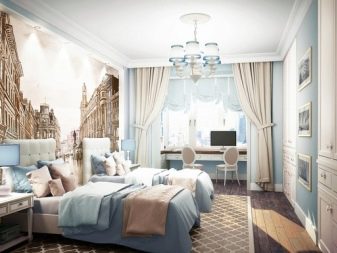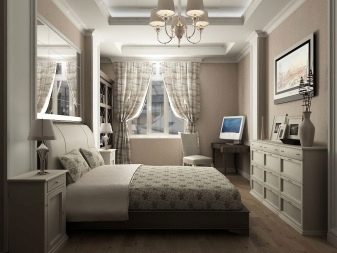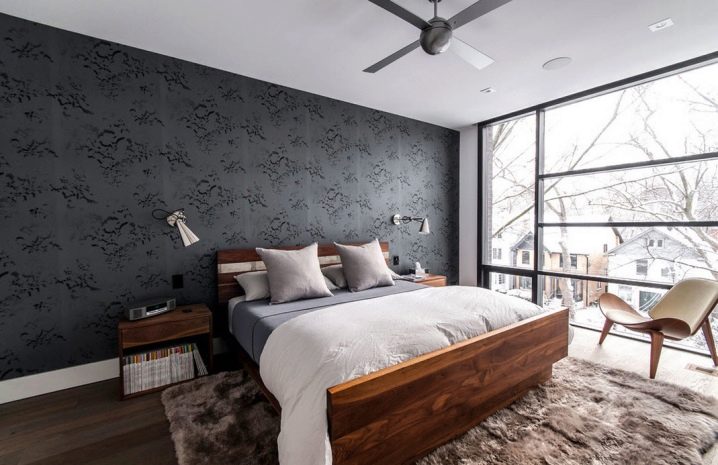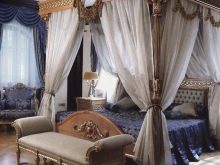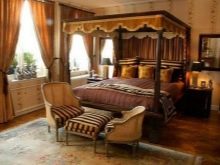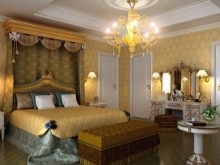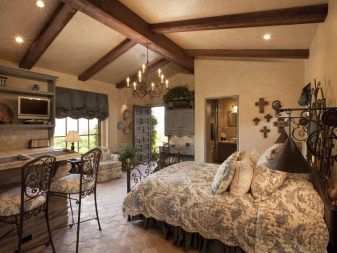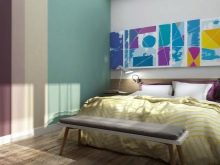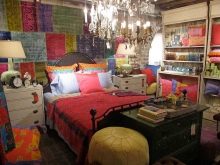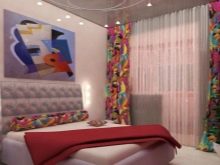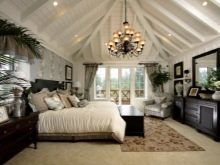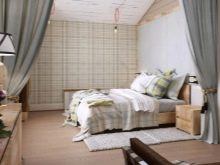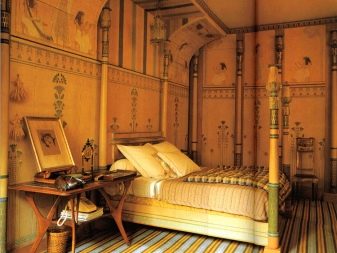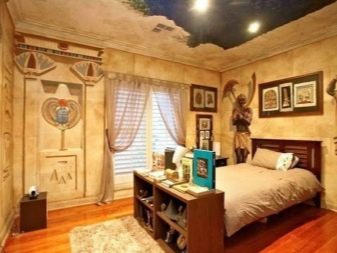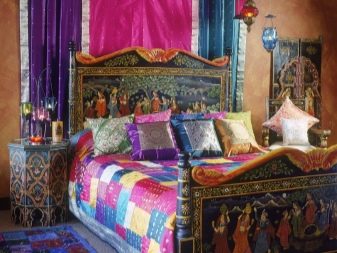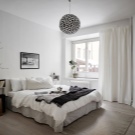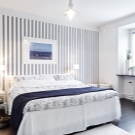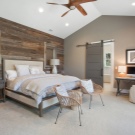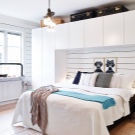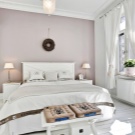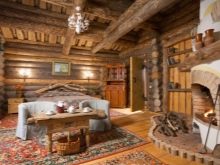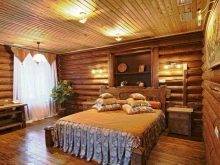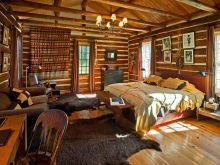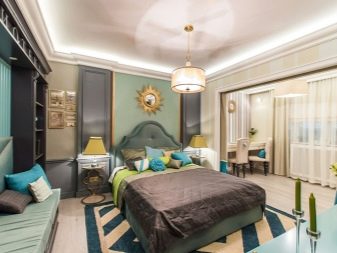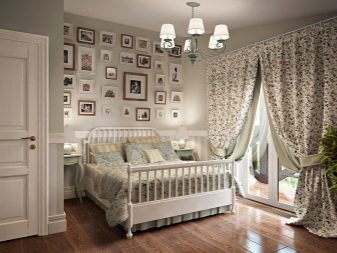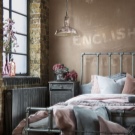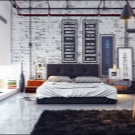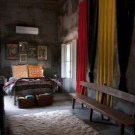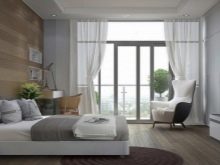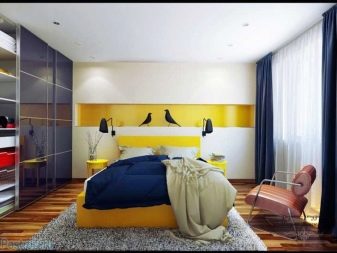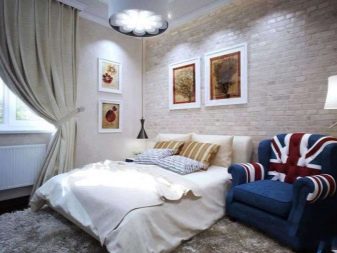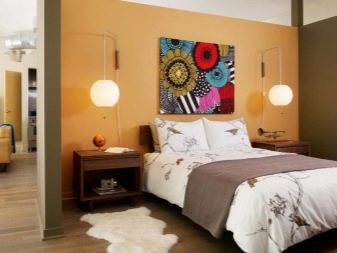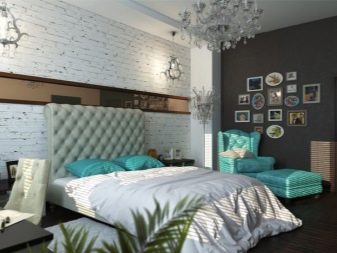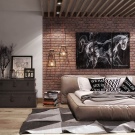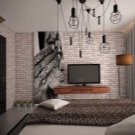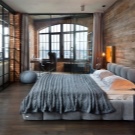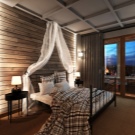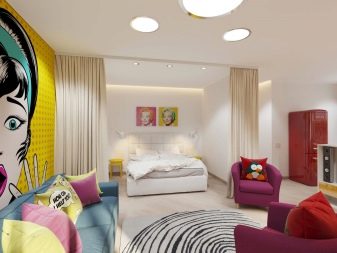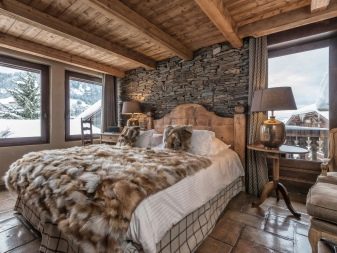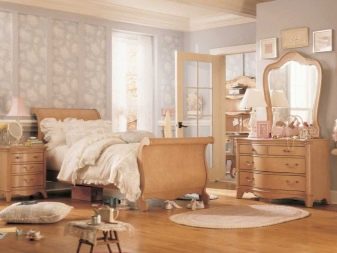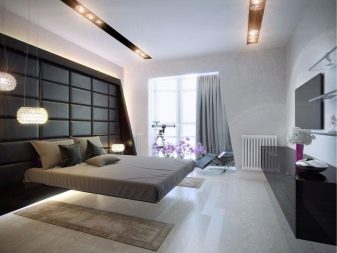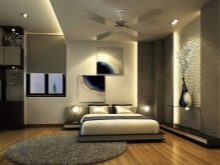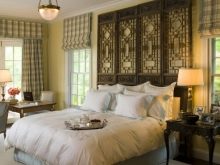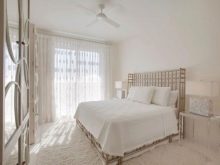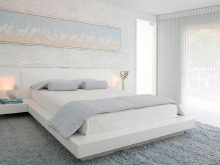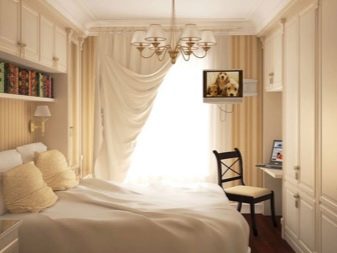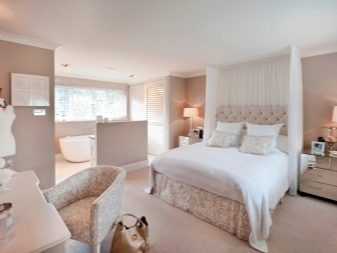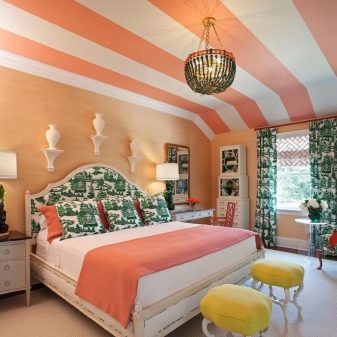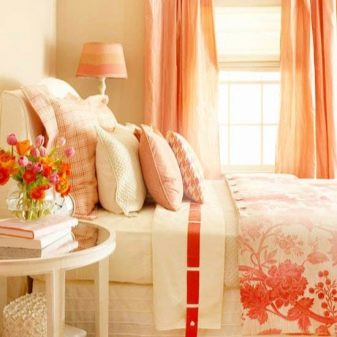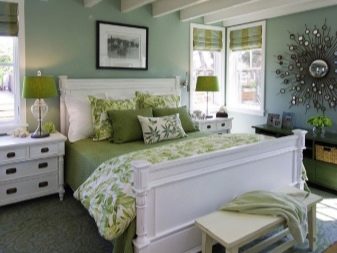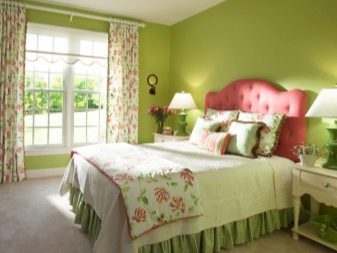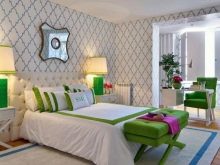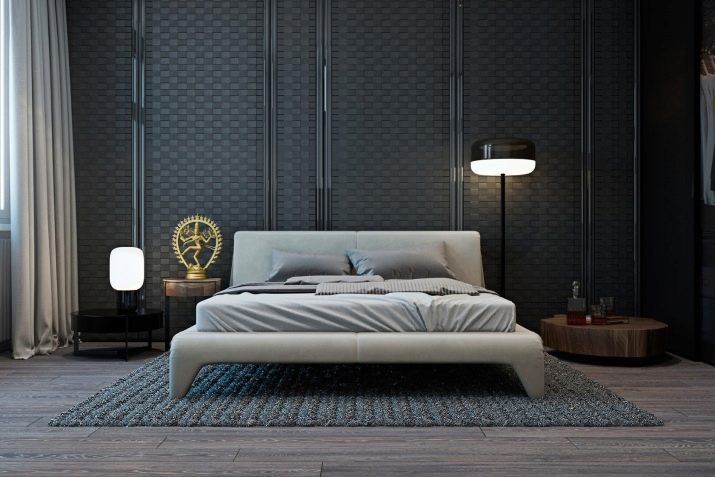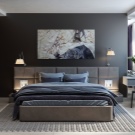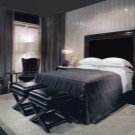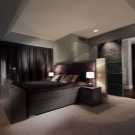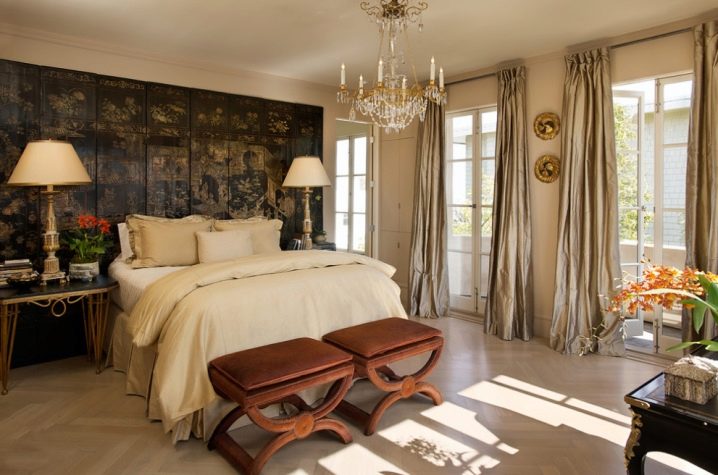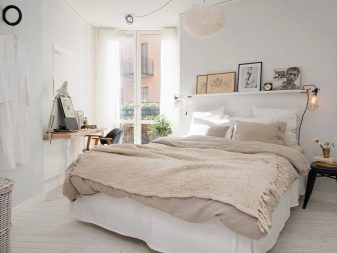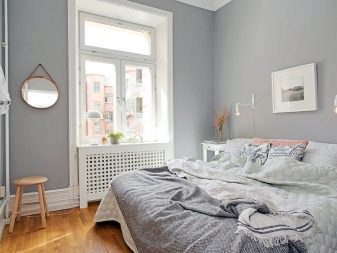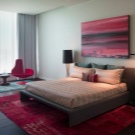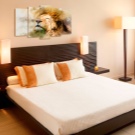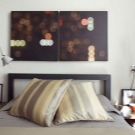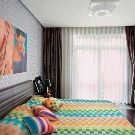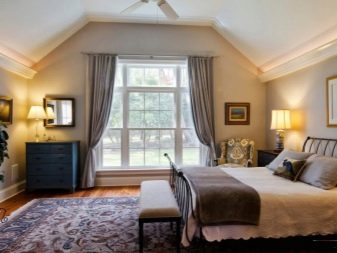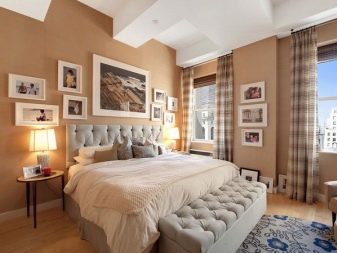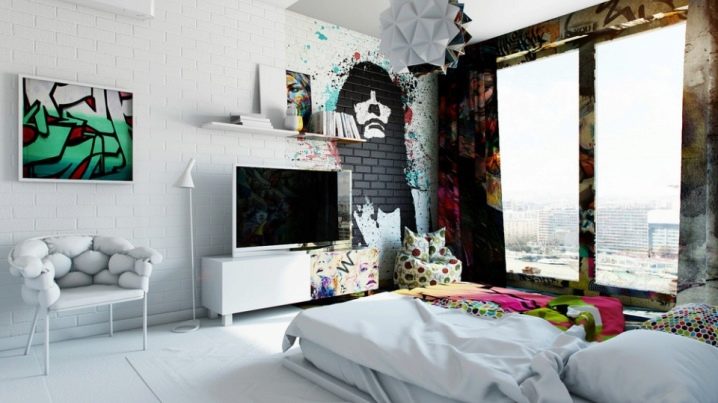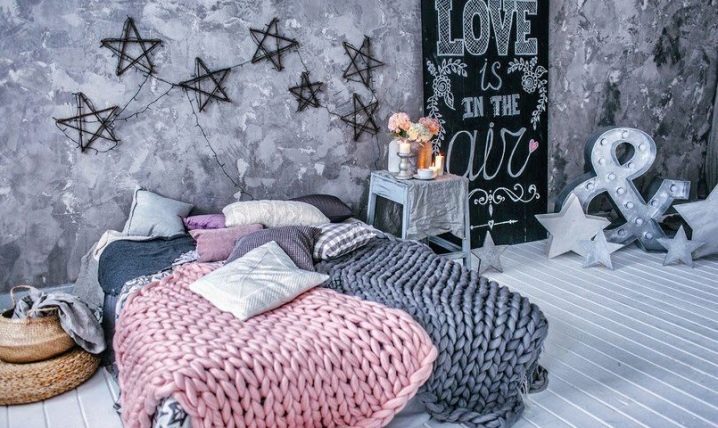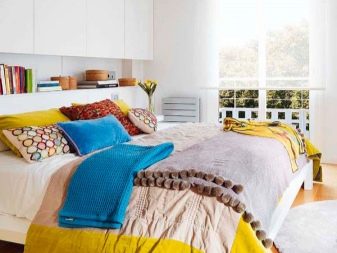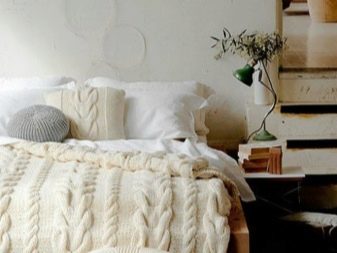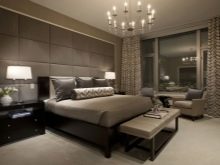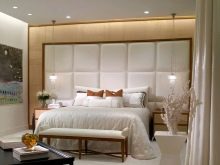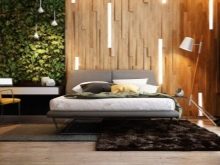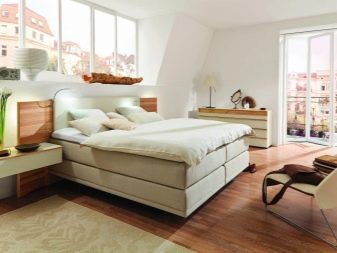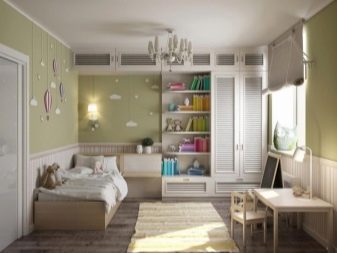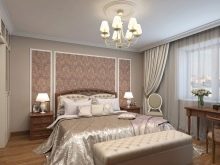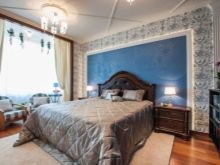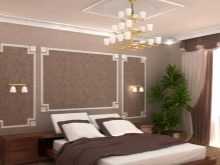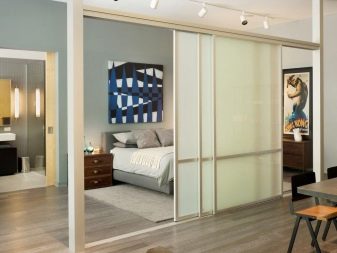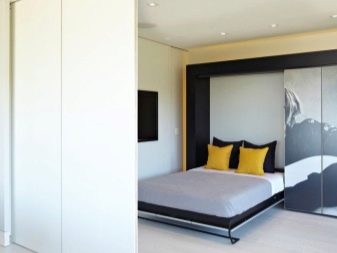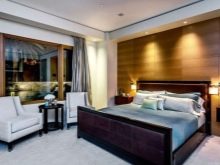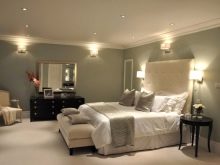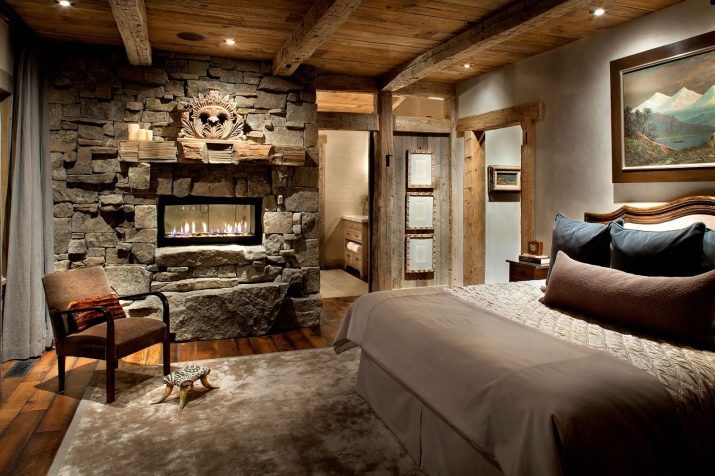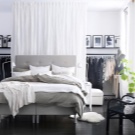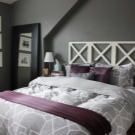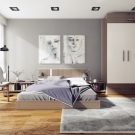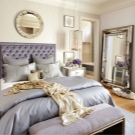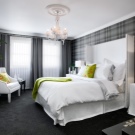Choosing a bedroom design
Harmony and comfort are the features of an ideal home that only those who already have it do not dream of. It is difficult not to agree that it is more pleasant to cook in the kitchen, equipped with the most functional and tasteful, to receive guests in the luxurious living room, to care for yourself in the beautiful bathroom. The design of the bedroom often fades into the background, since this room is not intended for receiving guests. The bedroom is usually isolated from the rest of the rooms, but its design should at least in small things overlap with the design of the whole house, only then it will be complete and harmonious.
Original solutions
Modern design projects strive to ensure that the bedroom looks fresh, spacious, stylish - and at the same time remains cozy. Some “chamber” is necessary, which is positioned towards a state of relaxation, and an individuality inherent in the intimate zone.
Tightly curtained windows and a double bed in the center of the room, regardless of its size and shape, are remnants of the past. Experienced designers advise to experiment with the position of the furniture in the room, its shape and dimensions, with accessories and decor.
It is important to be able to take a fresh look at all the flaws of the layout and find the use of previously not functioning zones. Maybe it is in them that you can install an angular bookshelf, built-in furniture, open storage systems. Perhaps this impractical alcove at the head of the bed is the perfect place for an electric fireplace.
Layout
The shape of the room is very important when choosing style-forming elements.. The rectangular or “penile” shape of the room is a frequent occurrence in the houses of Soviet buildings. Some of them are so narrow that they resemble second-class carriages, and this does not at all make them convenient for creating an original bedroom design.
The main purpose of arranging a narrow room is to visually bring its shape to the coveted square. It is better not to use only standard methods of expanding space - such as reflective surfaces and light walls. It is necessary to refer to all the tricks of designers:
- The correct color combination in the design of the walls. The reception is designed for visual expansion of short walls and reduction of long ones. The first shade should be light, it should be placed on the oblong side, and the second should be dark (to make it short).
- Wall mural with perspective. A city landscape stretching to the horizon, a mountain range tending into the distance, and any other images with the most distant background, greatly increase the depth of the long wall.
- Window decoration The more natural light in the room, so it is more spacious, so it is better to refuse dense curtains. But light drapes distract attention from the walls.
- Proper room zoning. Various podiums, compact furniture, bright carpets, mobile partitions - everything that creates multi-level verticals helps to visually transform the “penny” space.
- Designing niches. Even a small depression in the longitudinal wall makes the setting dynamic. You do not need to make it functional, even if the niche only works to expand the space.
- Large mirrors. The traditional technique, which implies a visual increase in the room due to the mirror surface along one of the long walls.
- Horizontals. Parquet, laminate, porcelain, boards - any of these materials on the floor should create a perpendicular with long walls.
- Smooth corners. Color design of the walls, decor, original furniture soften straight lines and help to get rid of the compartment effect in narrow rooms.
- Minimalistic furniture. The less cabinet furniture in a small room, the better. Long walls provide great opportunities for arranging open shelves on them for storing or installing built-in wardrobes.
- Artificial lighting. Additional lighting (spots) diversifies the interior and “spreads out” the walls in a narrow room. Proper placement of light accents simulates natural light, making the room more spacious.
In a room with high ceilings, it is important to use the upper zone of the room. This can help ceiling beams, chandeliers with multi-level fixtures, light paper ceiling and other decor in a specific style.
Square or slightly elongated bedroom with one window - the best option in terms of planning. It does not require special design tricks for visual change of shape, but in a small room some tricks are necessary:
- Light finish. If in the case of rectangular rooms it is not very efficient, then it works perfectly in square rooms. The lighter the decoration of the room, the less noticeable the boundaries between the walls and the ceiling. The room seems spacious, full of air and light.
- Monochrome An absolutely white bedroom will look much larger than it really is, but you should think about the practicality of such an interior and its aesthetic perception.
- Minimalism. The less cluttered the space, the freer it looks. You can optimize the area of a small room with the help of transforming furniture.
- The absence of large drawings on the walls and curtains. The curtains themselves are best replaced with light curtains or blinds that will not “eat up” an extra 30-40 centimeters of space.
- Proper use of bright accents. A few large items that attract attention are always better than a large number of trinkets.
- You can also use open shelves, reflective surfaces, the lack of a clear zoning of the room, the diagonal orientation of the lines on the floor.
Rooms with a non-standard layout (triangular, trapezoidal, with a sloping ceiling) are the most complex type to create a design. In an irregularly shaped bedroom, it is very important to turn flaws into virtues, rather than trying to disguise them in different ways. The bay window can be a great place to read books if you properly arrange the window sill, and the columns and the arch will set the foundation for the antique style.
Whatever the unusual shape of the bedroom, it requires accuracy and professionalism in creating the design.
It is recommended to look at the selection of projects for identical rooms and try to create your own - with the help of computer programs. Ideally, you need the help of a design professional.
Materials
Particular attention should be paid to the choice of materials for repair. This choice is directly related to the dominant stylistic direction in the interior of the house. For the historical styles are relevant dense wallpaper with a pattern, upholstery, decorative plaster, and modern trends prefer light negligence and unusual textures.
For the ceiling
The white ceiling is a classic of the genre in the interior design, but in the modern design of the bedrooms other solutions are acceptable. The range of building materials is constantly expanding, offering new solutions for the interior. The following types of cladding are popular among designers and repairmen:
Whitewashing or staining. At first glance it may seem that this is the most economical and easiest option to perform, in fact many unforeseen nuances may appear. The surface for whitewashing or dyeing should be absolutely flat, so you need to pre-seal the seams, process the ceiling with putty, clean and prime the work surface. The walls, the floor and all the objects in the room need to be packed in a building film so as not to paint anything extra.
Color does not necessarily have to be neutral, color corals will turn white into any desired shade.
Plaster. Cheap and cheerful, but at the same time - practical and aesthetic. Plaster the ceiling with your own hands. This material is easy to use, harmless, does not take precious centimeters from the height of the walls, for a long time does not require cosmetic repairs.
Stretch ceiling. The practical look of the cladding, which is easily mounted and dismantled, helps to hide the wiring, does not require alignment of the surface of the ceiling before installation. Tension structures for a long time retain their original appearance, easy to clean. With their help, you can create a multi-level design and the play of light in the upper part of the room. The glossy surface reflects natural light, visually expanding the space of the room.
A wide range of colors also applies to the merits of such a lining.
The disadvantages include the fact that the installation of suspended ceilings will require additional space, and in a small room it may not be.
Rack (suspended) coating. Metal slats of various colors have good performance and aesthetic properties. With their help, you can create an interesting relief ceiling covering in the room of the correct form, with beveled corners and other nuances of the layout. They are versatile, practical, environmentally friendly, hide flaws on uneven surfaces and wiring, are easy to install and disinfect with ordinary detergents.
When choosing rails for ceiling design, it is important to remember that such a decision will cost a round sum, and the total height of the room will lose at least ten centimeters.
Drywall This is a plastic material that allows you to create a perfectly flat ceiling or fancy volumetric shape, dictated by modern trends in design. There is no "greenhouse effect", and therefore such material is more environmentally friendly. With it, it is easy to eliminate the strong differences between the ceiling tiles, and the finished ceiling can be used independently, and as a basis for painting, upholstery, wallpaper.
It should be borne in mind that repair with the use of drywall will be long and dirty. By itself, the material is heavy, with poor fastening on it may appear cracks.
Ceiling tile. Thin and almost weightless foam plates, which have a relief pattern on the front side, are a cheap and sought-after coating option. They are affordable (even colored models, mirrored and glossy surfaces), easily glued, and firmly held. Ceiling tiles can be washed and, if necessary, single replaced.
If you are going to start gluing the ceiling tiles, you will need to eliminate all the irregularities of the working surface.
Tree. More expensive than all the others, an elite type of finish. It can be used as a main coating or decorative (island).
It is very popular in modern "rural" interiors.
Ceiling wallpaper. Available in two versions: embossed white wallpaper with a rich choice of texture and options for coloring. Embossed wallpapers are only in white color and are produced by Russian manufacturers. They are difficult to maintain, but create a favorable relief on the ceiling. Foreign wallpaper can withstand up to 10 layers of paint in different colors.
For walls
The walls take the main share of attention, because their size is larger than the ceiling or floor area, they are at eye level. They form the basis of style, so the choice of material for decoration is especially important. None of them is considered bad, but each has its own advantages and disadvantages, which must be assessed before making a choice.
Traditional and time-tested finishes include staining and the use of wallpaper.
Coloring is an economical and easy to use method.. It can be very different - from monochromatic and smooth to textured and colored. Using paint creates additional volume in the room, 3D-drawings with perspective, original textured finish. You can use brushes, spray guns, stencils. You will get a quality washable coating.
Even more popular wallpapering. Paper rolls are gradually becoming a thing of the past because of their impracticality. Today’s popular views are:
- Non-woven wallpaper from fabric fibers and cellulose. They can be purchased both in color and under staining.
- Vinyl wallpaper increased density. The elastic, not fading, washing material which easily glues and differs in high operational qualities.
- Glass fiber Convenient and cheap material for staining.
- Liquid wallpaper. The most modern type of finish, the material is applied to the wall with a roller, like paint. After drying, no seams and joints remain, and the surface can be smooth or embossed - depending on the method of application.
Wallpaper and paint are reliable, but they have become bored during the long years of their existence. Repair in a modern bedroom I want to make more interesting and relevant, and for this There are other types of materials:
- Cork panels. Simple, eco-friendly, look beautiful on the walls, suitable for most modern styles, increase noise insulation and thermal insulation in the room.
- Decorative plaster. Durable, harmless, moisture-resistant and non-fading coating. It is applied to all types of walls, without requiring preliminary surface preparation. With its help, you can mask defects, irregularities, cracks and create an interesting textured wall decoration. Imitation of amber, marble, malachite, the creation of stucco, the embodiment of the palace style - these are just some of the possibilities of decorative plaster to be repaired.
- Ceramic tile. It is reliability, high aesthetic qualities, environmentally friendly and hygienic material. The tile is popular among designers due to the variety of decor and colors, the ability to be combined with any other materials.
- A natural stone. Stone on the wall is a bold decision in decorating the room. It can be large or small, flat or embossed, it depends on the size of the room and the desired effect.But such a surface in any case looks very beautiful.
Choosing a stone finish, do not have to think about what to put on an empty wall. A stone can be laid out textured pattern, and the finish is completely self-sufficient without too much decor.
- Decorative panels. Actually identical to stretch ceilings (in its properties and installation principle). Can be color, with a photo printing, a relief and additional lighting. Since the panels are capricious in relation to high temperatures and moisture, in practice they are not very common.
In many modern styles (especially creative decisions) are used non-traditional finishes:
- Brick or imitation. Looks good in natural form and for painting.
- "Naked" concrete walls a la "repair has just begun." A good background for wall decor and industrial styles.
- Double-glazed windows and glass blocks. Translucent colored walls used in studio apartments for room zoning.
- Tree. Costly coverage for eco styles and lovers of everything natural and safe for health.
The most courageous choose a short-lived, but original design.
The spectacular types of finishing "not like everyone else," who have not yet had time to get bored, include the use of decorative plaster, stucco and ceiling outlets on the walls. But “putting the house upside down” (using ceiling trim on the walls) is usually quite expensive, even if moldings are used to imitate stucco molding.
In this case, there is a budget solution - the use of old newspapers for finishing walls. Be careful with the choice of publication. Hardly advertising greenhouses or search for employees will decorate the room, but bright headlines and beautiful portraits are exactly what you need.
If you want something more practical, the solution will be OSB-panels, eco-leather upholstery, plastic panels with LED lighting, a flexible stone.
For the floor
Comfort and convenience in the bedroom will provide a warm floor, which is easy to clean and does not slip. The following materials meet these criteria:
- Linoleum. Economical, beautiful, durable coating. In modern execution it can imitate more expensive materials.
- Laminate. Aesthetic, practical, relatively cheap, easy to fit, it can be of different colors.The covering turns out warm and pleasant for bare feet.
- Self-leveling floors. Difficult to perform a coating, but perfect from an aesthetic and practical point of view. It is beautiful, like a good parquet, and pleasant to the touch, like rubber.
- Parquet. Prestigious finish of varnished wooden slabs. Parquet looks beautiful, but does not have good wear resistance and is capricious in care.
- Bamboo. Grass cover with wood imitation. It looks indistinguishable from parquet, but surpasses it in performance.
- Rubber. Durable, resistant to dirt, moisture and temperature extremes coating. An additional plus is excellent noise isolation. High-quality rubber must be Western-made, its synthetic substitutes are toxic and harmful to health ..
- Porcelain stoneware. Beautiful material that is “not afraid” of dirt, moisture and scratches. However, please note that without heating the floors will be very cold.
- Carpet. Warm, soft, pleasant to the touch floor, which also increases the level of noise insulation. It is easy to care for him, but such a surface should be protected from the sun.
It is important to remember that design is not a quick choice of a particular material, as well as color and silhouette.This is a single whole, an ensemble, which is formed by textures, colors, furniture and decor. With their harmonious combination, the interior acquires completeness and uniqueness.
Settlement Tips
How to make a bedroom cozy, practical and functional - questions that arise in anticipation of repair in the first place. At the same time, the patterned and traditional interiors are already pretty boring, and I want them to be replaced by more creative and non-standard solutions.
Modern bedroom should preserve the individuality and characteristics of personal space. To achieve this, the easiest way is to focus on gender, age, occupation and interests of the person for whom the premises are being arranged.
Children's and teenage bedrooms, as a rule, are at the same time a place to play, study and relax, so they need to be thought out especially carefully. It is important to correctly zone the room so that each class has its own place, and choose high-quality, safe and environmentally friendly materials for repairs and furniture.
It is very good if the child also takes part in drawing up a design project, then the room will definitely not seem boring and ordinary to him.
Bedrooms for one person can be male and female.
The “adult” room (as opposed to the nursery) combines the functions of a study and a place of rest. Less often, it is intended only for sleep. However, this does not mean that it should be banal. An interesting situation is pleasing to the eye and sets up a positive mood in any place, so a special attention should be paid to the design of a bedroom for an adult.
Female bedroom is most often luxurious, light. It is necessary to equip a comfortable bed, women's corner, a place to store things. The ideal bedroom each lady dreams of is a room with a built-in wardrobe.
It is also worth considering a zone for creativity, work or a hobby. A padded easy chair and a bookcase will be useful for lovers to read, business women need a functional area with a computer desk, and needlewomen just need a sewing corner in the bedroom.
A men's bedroom can also serve as a place to rest and work.. It should be trimmed with such materials, for which you do not need to care for often, and furnished only with the most necessary items.Its characteristic features are simplicity, “brutality” and extreme clarity in the stylistic direction.
When zoning a room, representatives of office and technical specialties need to think over a zone with a comfortable desk and office equipment, creative individuals will need free space, as well as furniture that can be easily moved from place to place. Musicians should take care of high-quality sound insulation.
A bedroom for two is a special occasion. The situation in it must be a compromise that unites male and female traits and retains some intimacy.
The main role is assigned to a quality bed, the width of which is not less than 140 cm.
Of great importance is the type of room. It is one thing when it comes to arranging a bedroom in a small apartment, and quite another if repairs are planned in a private house or in a cottage. The apartment is required to correctly use the methods of visual increase in space, and in the house and the cottage it is wise to approach the creation of an unusual layout.
Popular interior styles and finishes
When it comes to design in a historic or modern style, it is not very easy to determine the boundaries of a particular direction. However, this is possible if you take a closer look at their characteristics.There are three main areas - historical, ethnic, modern. They are divided into several more directions.
Historical style includes antiquity, avant-garde, art deco, empire, baroque, victorian, gothic and romantic styles, classicism and neoclassicism, constructivism, renaissance, modern, rococo, eclecticism. It requires large areas, a developed sense of taste, as well as measures, an understanding that historicism is not a museum setting. Given these nuances, it will not be difficult to recreate the luxurious romance, respectability and severity of past eras in your own home.
Antique (Greek) style
The roots of it go back to deep antiquity, but it is quite popular these days. Its foundation is sophisticated luxury. Distinctive features:
- Greek symbolism and ornaments. The motives of winemaking, flora and fauna, geometric figures in the design of the floor and walls are welcome. Authenticly look mosaic, murals (you can replace the paintings on the walls), interspersions of marble, columns and arches.
- Symmetrical furnishings and straight lines.
- Light walls with a bright accent in the form of a picture or tapestry.
- Soft lighting that imitates the light of candles and torches, light cornices, wall lamps of non-trivial forms.
- Drapery fabrics, curtains, carpets, artificial animal skins.
- Massive low furniture.
- Light doors.
Avant-garde
The style has a talking title, which implies revolutionary changes of the twentieth century - in the well-established ideas about the "right" room design. It is characterized by:
- Bold color combinations and play on contrasts.
- Unusual silhouettes, broken lines, expressive outlines of furniture and walls.
- Unusual symmetry: a live potted plant duplicates its image on the wall.
- Decorative materials in the decoration: suspended ceilings, gloss, liquid wallpaper.
- Furniture of non-trivial forms, concentrated in the center of the bedroom, and functional built-in furniture.
- A large number of sources of artificial lighting.
Classicism
Incarnate aristocracy, which is characterized by elegance, restraint and minimalism. The handwriting of classicism is noticeable in the following elements:
- The decorative character of the decoration of the room and furniture: painting, stucco, parquet, noble sorts of wood.
- Clear relief and large objects.
- The presence of large mirrors.
- The central element on which all attention is focused. In the bedroom it can be a canopy bed.
- Squat, nice furniture on the impressive figured legs.
- Cream, beige, greenish and brown shades.
- Fireplace and good lighting.
- Characteristic accessories: vases, sculptures, flowers.
Neoclassicism - this is conservatism. Minimalistic and luxurious antiques are made of modern materials, and this is the main difference from classicism.
Modern It represents the most “epochal” style, extravagant, arty, combining technological effectiveness and “embellishment”, forever remaining in the stage of active transition from established forms to new ones. His follower is art deco, he has more modern options and bold, but not chaotic combinations of objects from different directions.
Empire - respectability and elitism, requiring large areas for solid furniture with figured legs. Baroque and Rococo - multi-tiered, pompous, bombast, a tendency to excess, typical of palace interiors.The most beautiful by the standards of time, elegant and expensive things - the basis of these styles. Renaissance and Victorian style are close to royal standards.
“My home is my fortress” is the creed Romanesque and Gothic, with their thoroughness and monumentality, a dark palette and coarse materials. In part, it echoes constructivism, in which everything is called by its proper names. A chair is a chair, it is only a functional piece of furniture, and non-functional products are not used.
Expressionism - This is a creative attempt to incorporate the features of all spheres (from theater to cinema), while deforming the usual forms, turning housing into a stage for everyday household performances. And at the junction of all styles is eclectic, skillfully combining the best of them.
Ethnic styles have truly unique characters. English bears the features of pedantry and cozy stiffness, African and Moroccan reproduce in the colors of yellow-brown, terracotta, brick and blue shades of scorching sun, dry grass and cloudless sky.
Oriental (including Chinese and Japanese) combines all the elements of the identity of Asian peoples.Oriental style is good for the bedroom because it is not very typical for Asian culture to flaunt the circumstances of the life of the household, so the room will be cozy, fabulous and very intimate.
Egyptian the style evokes persistent associations with the pyramids and the pharaohs, and the pyramids are symmetrical, precise geometry, columns and characteristic symbols, decorated in a big way with gold, draperies and interesting accessories.
Indian the style combines the asceticism of poverty of the lower strata of the population and the luxury of the wealth of the higher castes; the Mexican one abounds in national color, mixing material culture with European ideas of convenience.
Scandinavian the style is built on the simplicity and contrast of the functional designs and decor. Mediterranean is laconic volumetric things, often handmade and made from natural materials, bearing traces of the cultures of Greece, Turkey and Italy. This style has to relax and detachment from everyday fuss. It echoes the tropical style.
Russian style is not a jumble of ethnic souvenirs (like a nesting doll and a samovar).This is the abundance of wood in the decoration and furniture, the obligatory presence of textiles, a beautiful chest of drawers or chest, a fireplace or its imitation, a minimum of souvenirs, especially foreign ones.
American Style is flexibility and democracy, full freedom for self-expression and demonstration of addictions.
Provence with a touch of bourgeoisness, “with history”, an abundance of light and soft shades is closest to modern trends.
Popular modern trends are focused on room design without the use of elaborate furniture, expensive materials and decor in abundance. They are aimed at simplicity, functionality and free space. Among them there are more than a dozen areas, and some of them deserve special attention.
Grange
This is a democratic combination of modernity and antiquity, a demonstration of elegant, sturdy things and materials chosen with taste. Furniture in the style of classicism loses gilding and carved patterns, the floors of marble are replaced by a more practical and affordable lacquer coating. Curtains with a large number of folds are facilitated by curtains of translucent flying fabrics. Among the distinctive features are particularly vivid:
- Laconic, but massive subjects.
- Dummy high cost or imitation of noble materials.
- The abundance of natural fabrics: linen, cotton, silk.
- Antiquities, antiques, vintage items.
- "Hereditary values" in the form of bronze figurines, candlesticks, mirrors.
Contemporary
Youth style in which everything is executed without excesses. They say about this "simply and with taste." At the same time, a pleasant for living and comfortable room at any time can be diluted with a new object, as if continuing the unfinished composition of the situation. This makes the contemporary style dynamic and somewhat close to eclectic. Character traits:
- Easily moveable furniture (modular, transforming, on wheels, folding).
- Every thing is functional.
- Space saving due to compact arrangement of objects.
- The presence of bright, catchy, memorable accents.
- Hints at the presence of elements of foreign styles.
Fusion
Concentrated creative for those who do not like the everyday, boring and traditional.
However, the expressiveness of the style is achieved by contrast and the effect of surprise rather than by the general jumble of bright elements.For example, a fusion bedroom can be decorated with a single floor vase - if it is not a ten-liter transparent flask, but will occupy the entire space from floor to ceiling (a bright spot in the corner of the room).
It is easy to identify fusion among other styles by its characteristic features:
- Maximalism and extravagance of the situation. If accessories, then bulky, if chic, then conspicuous.
- Costly jewelry, because we are talking about design products.
- The combination of elements from different styles: academic painting of the Renaissance and the poster of a youth rock band next door.
- Bright palette, interesting color combinations.
- Expressive texture of materials.
- Bohemian.
Loft
Loft is a favorite youth style that has many incarnations (from orthodox industrialism with a touch of creativity to a distant reminder of them - using modern materials). The signs are as follows:
- Negligence of the situation: “uninhabited” room, mobile objects that are easy to move around the room, imitation of repair at the final stage.
- The abundance of light shades and natural light.
- Rough and natural textures in the bedroom.
- Windows to the floor without curtains.
- The combination of old and new, expressed in the neighborhood of a wooden bed with a new technique.
- Industrial features: rough furniture, open wiring and plumbing, metal surfaces and ceiling beams in sight.
Pop Art
Fashionable, bright, energetic design that is going from everything that can be caught in the store. Popular consumer products are transformed into works of art in it, and real works of art that break out of the ordinary, are cultivated and occupy a central place in the composition. Design features:
- The predominance of synthetic materials.
- Cheap accessories: posters for box-office films, plush cushions-hearts, artificially emphasized animal skin.
- Placing the same items at different levels.
- “Pop” decor items: Coca-Cola advertising poster, a sketchy portrait of a Cuban revolutionary.
- Carpets and rugs of different sizes, textures and colors.
- Furniture made of plastic or eco-leather.
Distributed stylish solutions in the spirit of "bungalows" and "chalets"- with original comfort and romance, surrounded by natural materials.The eco style is popular for minimizing the importance of the latest technologies in modern life. He is close in spirit to the romantic Chebbi-chic, urbanized country country, freedom-loving and cozy boho.
Postmodernism is designed for creative individuals, vintage - for connoisseurs of the beautiful from past eras. They are opposed to cutting-edge high-tech, cultivating the development of digital technologies and gadgets to improve life, techno with a predominance of geometric shapes and polymer-chrome-plated surfaces.
For those who do not like to rush from one extreme to the other and are on the border of a creative and technological boom, a beautiful, functional and maximally unloaded minimalism is intended.
Designers advise to use the universal tips for decorating the bedroom:
- Choose a specific style as a guide.
- Create a design project based on computer programs, ready-made samples or specialist assistance.
- Choose a color scheme that is pleasing to the eye.
- Consider placing a working area near a source of natural light.
- Find the best way to bedroom zoning (lighting, color, catwalk, folding screen,furniture arrangement, mats).
- Use the techniques of space optimization in small rooms.
- Calculate the required width of the bed - the number of sleeping.
- Carefully choose the right orthopedic base and quality bed.
- Provide double bed access from two sides.
- Consider the type of storage system and bedding.
Color solutions
New technologies and modern building materials have pressed traditional solutions in choosing colors for finishing the ceiling, walls, and floor. Now the palette depends only on the preferences of the owners, and the right choice is based on the recommendations of experts on the color design of the bedroom.
White color remains the favorite of many designers, as it is a universal “partner” for any other color and a backdrop for bright accents. Moreover, blotches of colored elements against a white background do not look separate, they are combined into a specific composition. This color is universal for finishing the ceiling and walls (different materials), but for the floor should choose a more practical option.
Close to white milky color. This warm shade is designed for cozy interiors in historical styles, and for more modern cold, “signal” white is suitable.
Original and self-sufficient looks powder color. It is deep, soft and perfect for both monochrome performance, and for combination with brighter elements.
It is appropriate in the bedroom a gentle palette, conducive to relaxation and tranquility.
Relevant to the lounge in peach tones. Cream, flaxseed, olive, pistachio, light green, mint bases are suitable for a large number of interiors recreated in the bedroom. So that the monotony does not seem faceless, you should add juicy color accents: plum, coral, gold, coffee, emerald, terracotta, cherry.
Psychologists say that green palette in a combination of different shades is the most soothing and pleasing to the eyes and nervous system. It will not be too boring and simple - and at the same time it will not cause irritation and will not get bored for a long time. Dark greens go well with white, golden, brown, wine, African wenge.Successfully combined burgundy and purple.
Fresh and modern look. combinations of bright but not flashy colors: yellow clay and Prussian blue, cream and amber, cream and plum, sunny yellow and sky, pear and sangria, lemon cream and shades of precious stones (emerald, sapphire, ruby), honey and cinnamon.
Do not be afraid of the dark scale. The cool tones of blue, brown and gray will make the bedroom modern and unusual, and not at all gloomy.
Choice of furniture and accessories
Regardless of whether budgetary redecoration or luxury renovation is conceived, the primary task is to think over the decor of the room to the smallest detail. Not everyone can immediately figure out how to furnish it, how to decorate it, where to equip this or that functional area.
The appearance, size and function of the furniture determines the style in which the interior of the room is made. For historical styles more suitable luxury furniture, high-quality and durable. Ethnic or colonial style requires something authentic and recognizable, and modern trends can afford everything, including designer products and handmade furniture.However, this is not the only criterion. There are other useful "cheat sheets" for choosing furniture:
- Consider the purpose of the room. In the bedroom, which is used only for rest, the main place is reserved for sleep, and therefore a large and comfortable bed can occupy a significant part of the room. For a bedroom-office, more compact sleeping systems are needed, which are transformed during the daytime and do not take up much space.
- Choose a bed or sofa with a sturdy frame and orthopedic foundation. Fittings and transformation mechanisms must be in perfect working condition.
- Give preference to environmentally friendly and safe materials.
- Take into account the height, weight and number of sleeping, take into account the permissible norms in the instructions, otherwise the product will quickly become unusable.
- Do not purchase single and double beds already 140 cm.
- If there is a choice, give preference to built-in rather than cabinet furniture.
- Observe the measure. All non-functional things are a waste of money and free space.
Accessories
Thinking through the interior, each owner thinks about how to decorate a room, what to hang on the wall, how to decorate a window, what accessories to choose.The answers to these questions are inherent in the specific style, but there are also Universal design options that are relevant in most cases:
- Pictures The direction in art to which the picture belongs, depends on the style prevailing in the interior. The design of the canvas looks beautiful with a simple wooden frame, a good option is a baguette made of wood, plastic or aluminum.
It is worth paying attention not only to familiar paintings, but also to collages, panels, mosaics and patchwork.
- Photo. Famous work of a photo artist or a beautiful family photo will make the atmosphere in the bedroom more homely and warm. Posters are appropriate in the youth bedroom.
- Drawings. Landscapes on the walls with 3D effect and perspective, a picture on the wall instead of a canvas and any other image will give the room individuality. Apply the picture with your own hands, using spray paint and stencils.
- Handmade. Original things help to create handmade things: knitted rugs, lampshades for lamps, souvenirs.
- Textile. Soft accessories (curtains, curtains, canopies, blankets and bedspreads, pillows) make the bedroom cozy.
- Antiques and vintage. Floor clocks, "Grandma's" floor lamp, decorative chest and other attributes of past years are relevant in most styles, they make the design more interesting and "expensive".
- Carpets and Bedside Rugs. They not only complement the interior, these products are practical if the floors are unheated.
- Light fixtures. Artificial lighting plays a special role in the setting. The decorative lamp is good in itself and for creating additional volume and highlighting zones in the room. An electric fireplace or a large aquarium with original lighting looks great as a light source.
- Related furniture. Rarely it is enough only beds in the bedroom. Someone lacks a chest of drawers or a locker, someone needs suspended shelves, and someone needs a whole bench for the usefulness of the interior in the Russian style. The main thing - do not overdo it, making up a furniture ensemble.
- Moldings - decorative strips for finishing any surfaces, giving them a more complete look.
- Designer zest for complex interiors.
In a studio apartment, you may need mobile partitions so that the kitchen, bath, shower and toilet are isolated from the bedroom.
Lighting and bedding
Success is in the details, and this is not only the obvious accessories, but also thinking through the little things that create style.
Artificial lighting plays an important role in the interior of the bedroom. With its help, the space is visually increased, the functional zones of the room are highlighted, and coziness is created.
Space Transformation Techniques:
- Increase the height of the ceiling. It occurs due to the installation of lamps on the walls, the rays of which are directed upwards. This light visually lifts the ceiling line.
- Narrowing the "penny" bedroom. Placing a light in the center of a room is a common mistake. The optimal solution for narrow and long rooms is the location of lamps on one of the long walls or an L-shaped arrangement along the longitudinal and long narrow walls.
- Extend the room can be just by placing the same lamps in one row in the center of the ceiling. This will create the necessary perspective.
- Changing the overall size of the room. The main trick is to create reflected and diffused light. The more reflective and glossy surfaces, the better.
- Bedroom zoning. Local lighting near the furniture, above the table, around mirrors or paintings delimits the space better than any other reception.
When choosing bedding it is necessary to consider their compliance with the color scheme of the interior, convenience, quality and naturalness of materials, time of year.
You can find more ideas for bedroom design in the next video.

